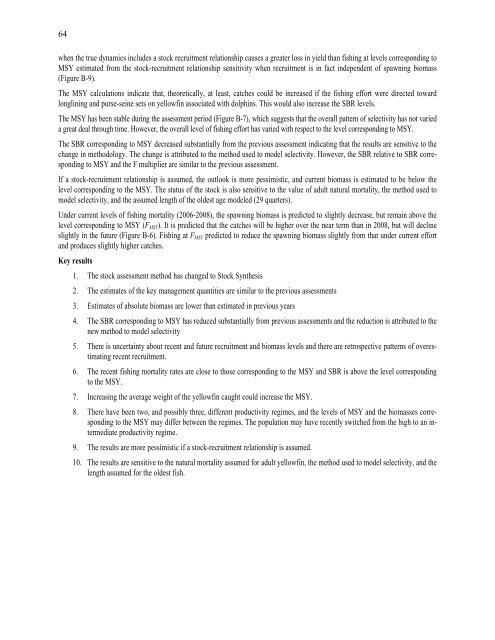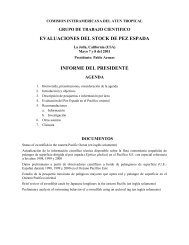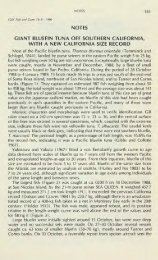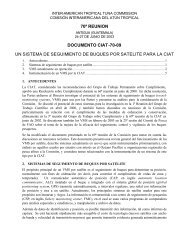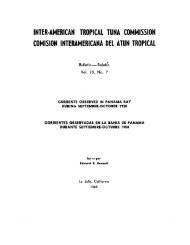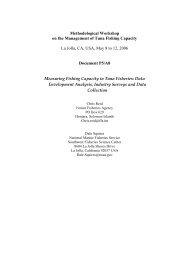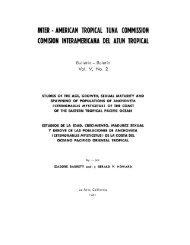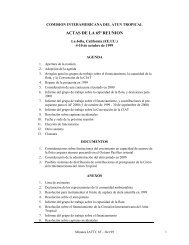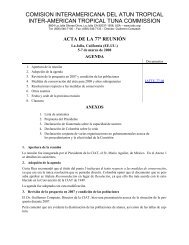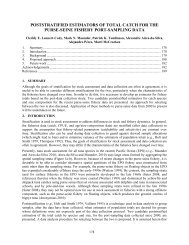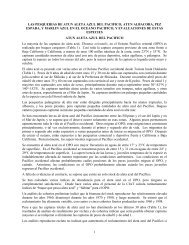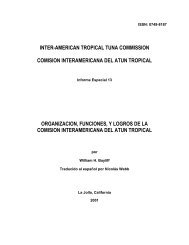INTER-AMERICAN TROPICAL TUNA COMMISSION - Comisión ...
INTER-AMERICAN TROPICAL TUNA COMMISSION - Comisión ...
INTER-AMERICAN TROPICAL TUNA COMMISSION - Comisión ...
- No tags were found...
You also want an ePaper? Increase the reach of your titles
YUMPU automatically turns print PDFs into web optimized ePapers that Google loves.
64when the true dynamics includes a stock recruitment relationship causes a greater loss in yield than fishing at levels corresponding toMSY estimated from the stock-recruitment relationship sensitivity when recruitment is in fact independent of spawning biomass(Figure B-9).The MSY calculations indicate that, theoretically, at least, catches could be increased if the fishing effort were directed towardlonglining and purse-seine sets on yellowfin associated with dolphins. This would also increase the SBR levels.The MSY has been stable during the assessment period (Figure B-7), which suggests that the overall pattern of selectivity has not varieda great deal through time. However, the overall level of fishing effort has varied with respect to the level corresponding to MSY.The SBR corresponding to MSY decreased substantially from the previous assessment indicating that the results are sensitive to thechange in methodology. The change is attributed to the method used to model selectivity. However, the SBR relative to SBR correspondingto MSY and the F multiplier are similar to the previous assessment.If a stock-recruitment relationship is assumed, the outlook is more pessimistic, and current biomass is estimated to be below thelevel corresponding to the MSY. The status of the stock is also sensitive to the value of adult natural mortality, the method used tomodel selectivity, and the assumed length of the oldest age modeled (29 quarters).Under current levels of fishing mortality (2006-2008), the spawning biomass is predicted to slightly decrease, but remain above thelevel corresponding to MSY (F MSY ). It is predicted that the catches will be higher over the near term than in 2008, but will declineslightly in the future (Figure B-6). Fishing at F MSY predicted to reduce the spawning biomass slightly from that under current effortand produces slightly higher catches.Key results1. The stock assessment method has changed to Stock Synthesis2. The estimates of the key management quantities are similar to the previous assessments3. Estimates of absolute biomass are lower than estimated in previous years4. The SBR corresponding to MSY has reduced substantially from previous assessments and the reduction is attributed to thenew method to model selectivity5. There is uncertainty about recent and future recruitment and biomass levels and there are retrospective patterns of overestimatingrecent recruitment.6. The recent fishing mortality rates are close to those corresponding to the MSY and SBR is above the level correspondingto the MSY.7. Increasing the average weight of the yellowfin caught could increase the MSY.8. There have been two, and possibly three, different productivity regimes, and the levels of MSY and the biomasses correspondingto the MSY may differ between the regimes. The population may have recently switched from the high to an intermediateproductivity regime.9. The results are more pessimistic if a stock-recruitment relationship is assumed.10. The results are sensitive to the natural mortality assumed for adult yellowfin, the method used to model selectivity, and thelength assumed for the oldest fish.


